Epidemiology Report: Critical Appraisal of Golley et al. (2007) Study
VerifiedAdded on 2023/03/30
|17
|4222
|82
Report
AI Summary
This report presents a critical appraisal of the randomized controlled trial conducted by Golley et al. (2007), which assessed a parenting skills training program aimed at improving parents' abilities to treat obesity in prepubertal children. The study focused on the effectiveness of lifestyle education for parents in mitigating childhood obesity, emphasizing the significant role of parental influence on children's dietary choices and lifestyle habits. The research utilized a 12-month intervention program that included parenting skills training and lifestyle education. Key outcomes assessed included metabolic profiles, BMI, height, and waist circumference z-scores. The report evaluates the internal validity of the study, discussing the logical sequencing of results, the potential influence of confounding factors like gender and parental structure, and the impact of blinding and allocation concealment. It further analyzes the causal association between the intervention and observed outcomes, highlighting the role of family involvement, the developmental stage of the children, and the importance of parental education. The report concludes by summarizing the strengths and limitations of the study, emphasizing the importance of family-centered interventions in managing childhood obesity and the need for further research to address identified methodological issues.
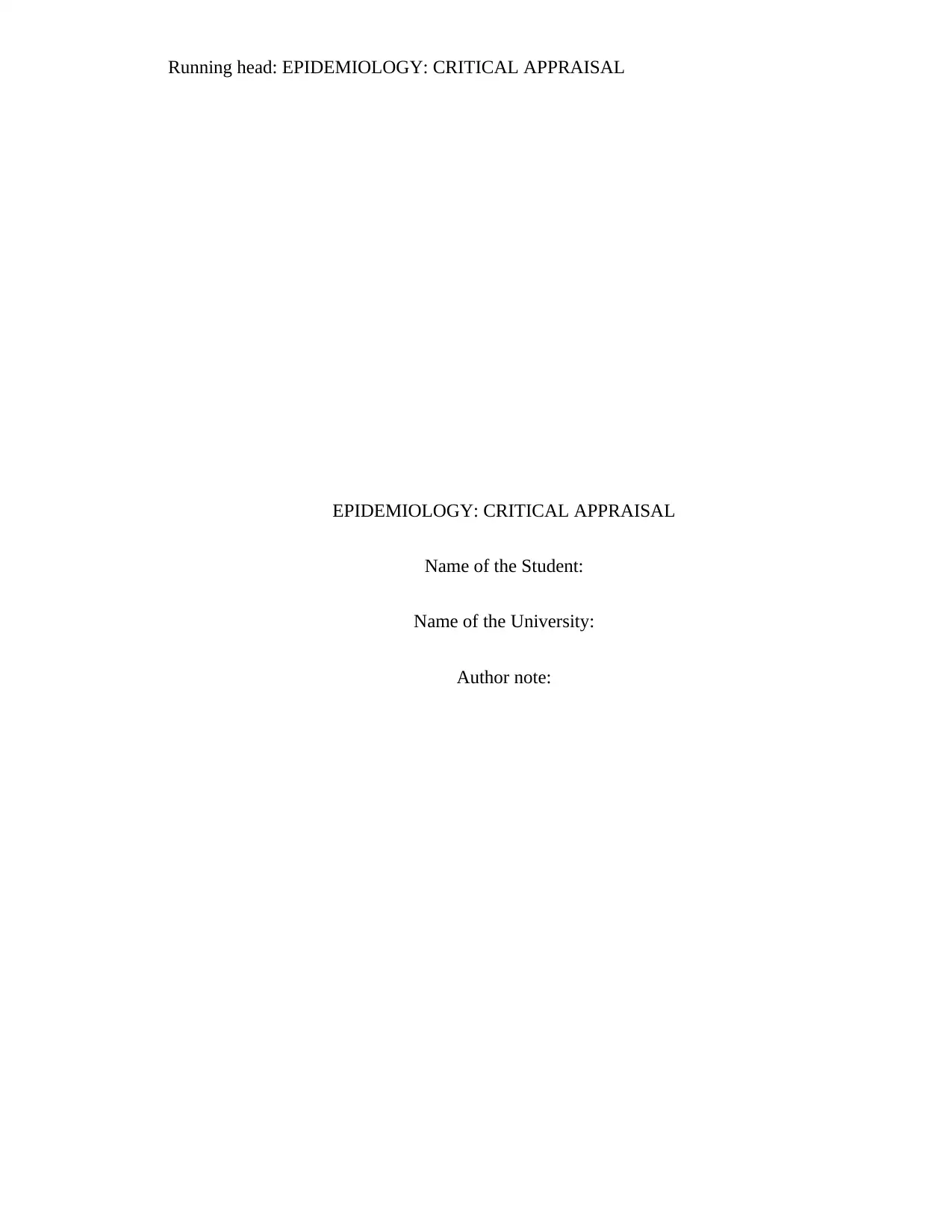
Running head: EPIDEMIOLOGY: CRITICAL APPRAISAL
EPIDEMIOLOGY: CRITICAL APPRAISAL
Name of the Student:
Name of the University:
Author note:
EPIDEMIOLOGY: CRITICAL APPRAISAL
Name of the Student:
Name of the University:
Author note:
Paraphrase This Document
Need a fresh take? Get an instant paraphrase of this document with our AI Paraphraser
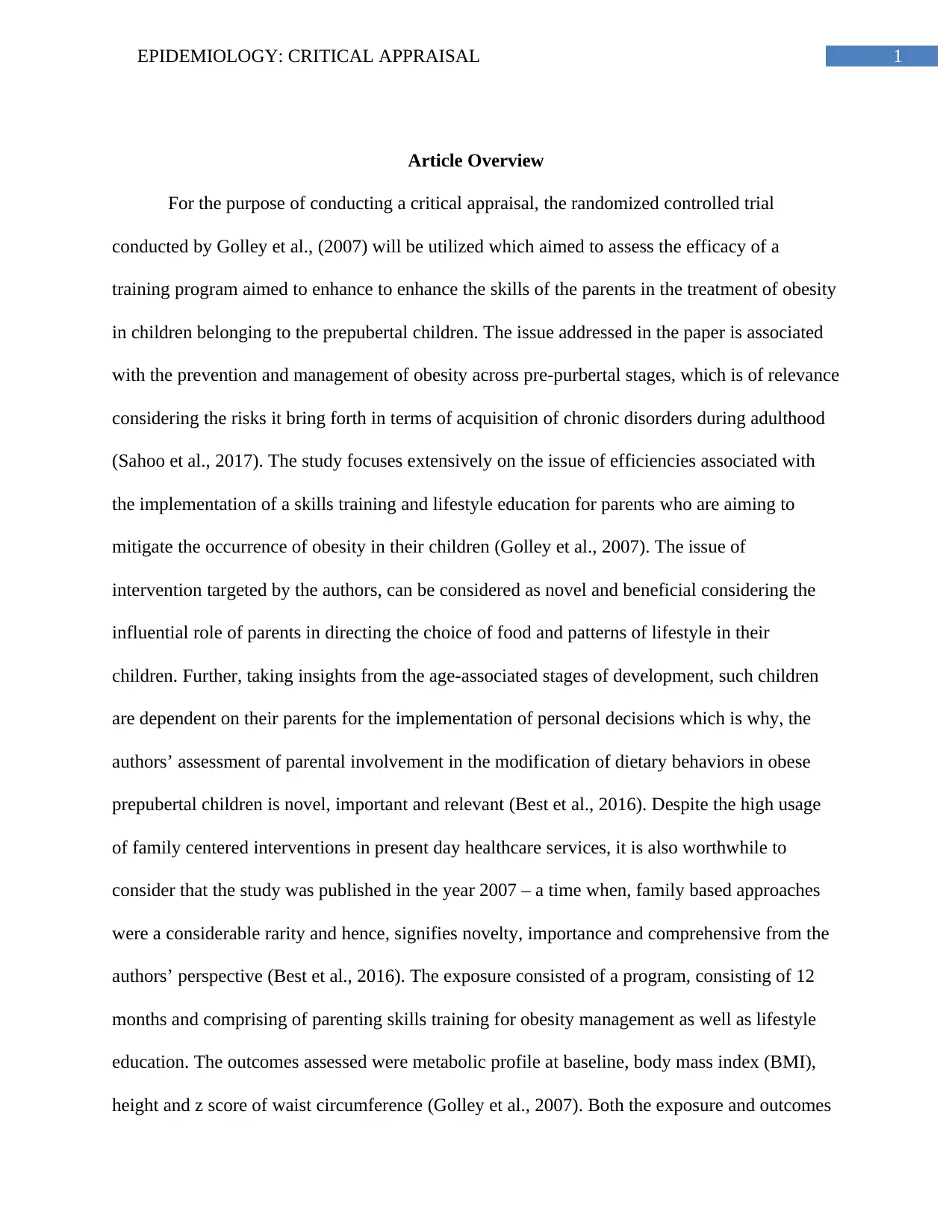
1EPIDEMIOLOGY: CRITICAL APPRAISAL
Article Overview
For the purpose of conducting a critical appraisal, the randomized controlled trial
conducted by Golley et al., (2007) will be utilized which aimed to assess the efficacy of a
training program aimed to enhance to enhance the skills of the parents in the treatment of obesity
in children belonging to the prepubertal children. The issue addressed in the paper is associated
with the prevention and management of obesity across pre-purbertal stages, which is of relevance
considering the risks it bring forth in terms of acquisition of chronic disorders during adulthood
(Sahoo et al., 2017). The study focuses extensively on the issue of efficiencies associated with
the implementation of a skills training and lifestyle education for parents who are aiming to
mitigate the occurrence of obesity in their children (Golley et al., 2007). The issue of
intervention targeted by the authors, can be considered as novel and beneficial considering the
influential role of parents in directing the choice of food and patterns of lifestyle in their
children. Further, taking insights from the age-associated stages of development, such children
are dependent on their parents for the implementation of personal decisions which is why, the
authors’ assessment of parental involvement in the modification of dietary behaviors in obese
prepubertal children is novel, important and relevant (Best et al., 2016). Despite the high usage
of family centered interventions in present day healthcare services, it is also worthwhile to
consider that the study was published in the year 2007 – a time when, family based approaches
were a considerable rarity and hence, signifies novelty, importance and comprehensive from the
authors’ perspective (Best et al., 2016). The exposure consisted of a program, consisting of 12
months and comprising of parenting skills training for obesity management as well as lifestyle
education. The outcomes assessed were metabolic profile at baseline, body mass index (BMI),
height and z score of waist circumference (Golley et al., 2007). Both the exposure and outcomes
Article Overview
For the purpose of conducting a critical appraisal, the randomized controlled trial
conducted by Golley et al., (2007) will be utilized which aimed to assess the efficacy of a
training program aimed to enhance to enhance the skills of the parents in the treatment of obesity
in children belonging to the prepubertal children. The issue addressed in the paper is associated
with the prevention and management of obesity across pre-purbertal stages, which is of relevance
considering the risks it bring forth in terms of acquisition of chronic disorders during adulthood
(Sahoo et al., 2017). The study focuses extensively on the issue of efficiencies associated with
the implementation of a skills training and lifestyle education for parents who are aiming to
mitigate the occurrence of obesity in their children (Golley et al., 2007). The issue of
intervention targeted by the authors, can be considered as novel and beneficial considering the
influential role of parents in directing the choice of food and patterns of lifestyle in their
children. Further, taking insights from the age-associated stages of development, such children
are dependent on their parents for the implementation of personal decisions which is why, the
authors’ assessment of parental involvement in the modification of dietary behaviors in obese
prepubertal children is novel, important and relevant (Best et al., 2016). Despite the high usage
of family centered interventions in present day healthcare services, it is also worthwhile to
consider that the study was published in the year 2007 – a time when, family based approaches
were a considerable rarity and hence, signifies novelty, importance and comprehensive from the
authors’ perspective (Best et al., 2016). The exposure consisted of a program, consisting of 12
months and comprising of parenting skills training for obesity management as well as lifestyle
education. The outcomes assessed were metabolic profile at baseline, body mass index (BMI),
height and z score of waist circumference (Golley et al., 2007). Both the exposure and outcomes
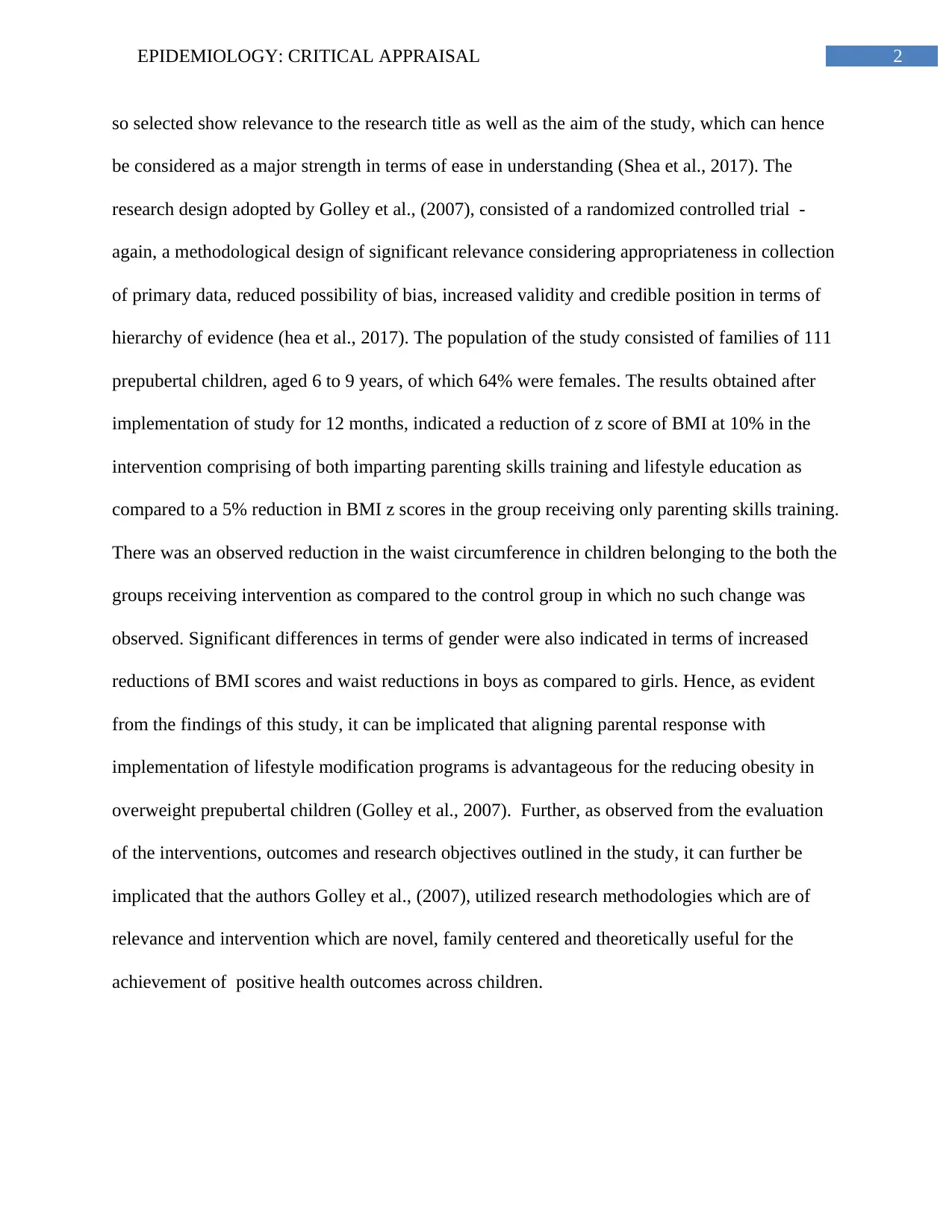
2EPIDEMIOLOGY: CRITICAL APPRAISAL
so selected show relevance to the research title as well as the aim of the study, which can hence
be considered as a major strength in terms of ease in understanding (Shea et al., 2017). The
research design adopted by Golley et al., (2007), consisted of a randomized controlled trial -
again, a methodological design of significant relevance considering appropriateness in collection
of primary data, reduced possibility of bias, increased validity and credible position in terms of
hierarchy of evidence (hea et al., 2017). The population of the study consisted of families of 111
prepubertal children, aged 6 to 9 years, of which 64% were females. The results obtained after
implementation of study for 12 months, indicated a reduction of z score of BMI at 10% in the
intervention comprising of both imparting parenting skills training and lifestyle education as
compared to a 5% reduction in BMI z scores in the group receiving only parenting skills training.
There was an observed reduction in the waist circumference in children belonging to the both the
groups receiving intervention as compared to the control group in which no such change was
observed. Significant differences in terms of gender were also indicated in terms of increased
reductions of BMI scores and waist reductions in boys as compared to girls. Hence, as evident
from the findings of this study, it can be implicated that aligning parental response with
implementation of lifestyle modification programs is advantageous for the reducing obesity in
overweight prepubertal children (Golley et al., 2007). Further, as observed from the evaluation
of the interventions, outcomes and research objectives outlined in the study, it can further be
implicated that the authors Golley et al., (2007), utilized research methodologies which are of
relevance and intervention which are novel, family centered and theoretically useful for the
achievement of positive health outcomes across children.
so selected show relevance to the research title as well as the aim of the study, which can hence
be considered as a major strength in terms of ease in understanding (Shea et al., 2017). The
research design adopted by Golley et al., (2007), consisted of a randomized controlled trial -
again, a methodological design of significant relevance considering appropriateness in collection
of primary data, reduced possibility of bias, increased validity and credible position in terms of
hierarchy of evidence (hea et al., 2017). The population of the study consisted of families of 111
prepubertal children, aged 6 to 9 years, of which 64% were females. The results obtained after
implementation of study for 12 months, indicated a reduction of z score of BMI at 10% in the
intervention comprising of both imparting parenting skills training and lifestyle education as
compared to a 5% reduction in BMI z scores in the group receiving only parenting skills training.
There was an observed reduction in the waist circumference in children belonging to the both the
groups receiving intervention as compared to the control group in which no such change was
observed. Significant differences in terms of gender were also indicated in terms of increased
reductions of BMI scores and waist reductions in boys as compared to girls. Hence, as evident
from the findings of this study, it can be implicated that aligning parental response with
implementation of lifestyle modification programs is advantageous for the reducing obesity in
overweight prepubertal children (Golley et al., 2007). Further, as observed from the evaluation
of the interventions, outcomes and research objectives outlined in the study, it can further be
implicated that the authors Golley et al., (2007), utilized research methodologies which are of
relevance and intervention which are novel, family centered and theoretically useful for the
achievement of positive health outcomes across children.
⊘ This is a preview!⊘
Do you want full access?
Subscribe today to unlock all pages.

Trusted by 1+ million students worldwide
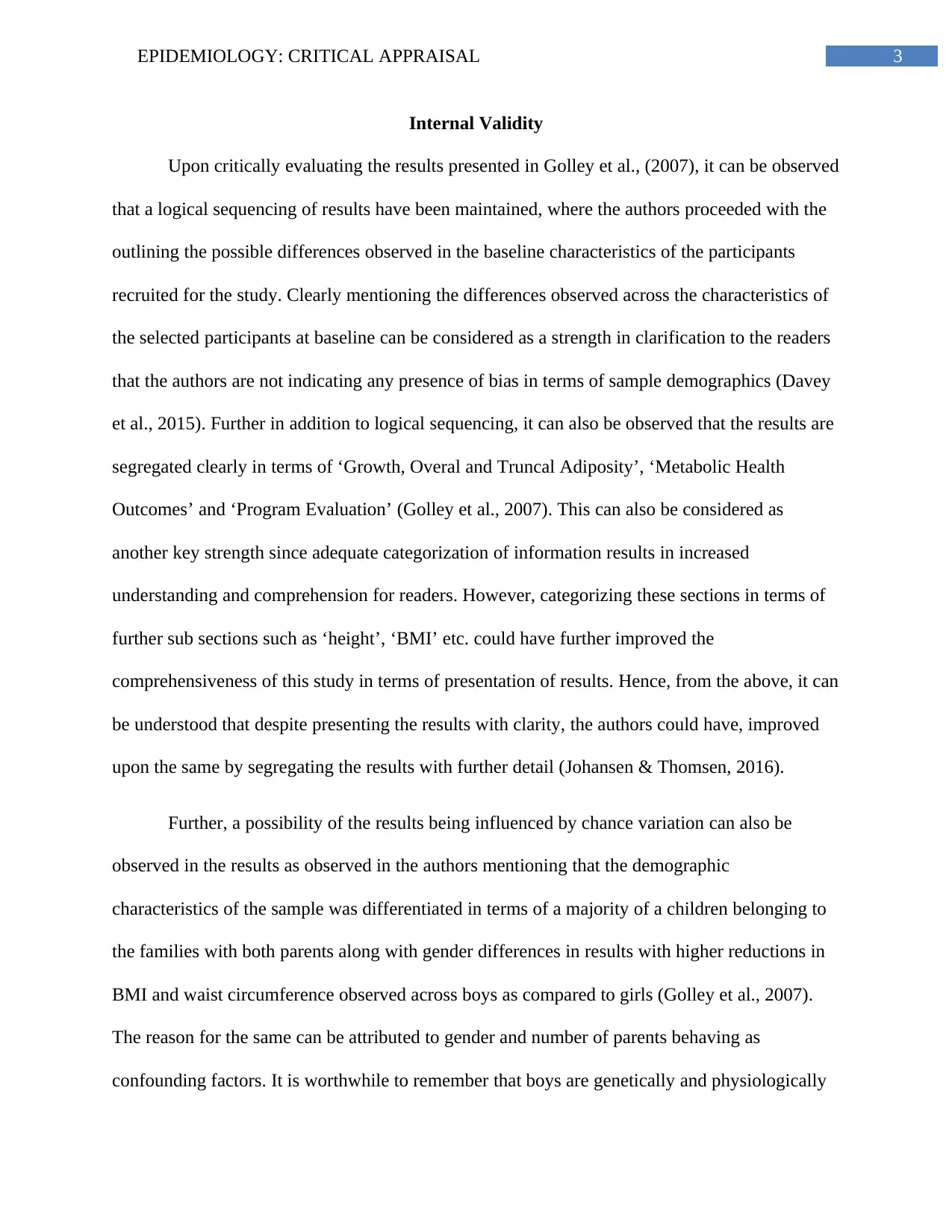
3EPIDEMIOLOGY: CRITICAL APPRAISAL
Internal Validity
Upon critically evaluating the results presented in Golley et al., (2007), it can be observed
that a logical sequencing of results have been maintained, where the authors proceeded with the
outlining the possible differences observed in the baseline characteristics of the participants
recruited for the study. Clearly mentioning the differences observed across the characteristics of
the selected participants at baseline can be considered as a strength in clarification to the readers
that the authors are not indicating any presence of bias in terms of sample demographics (Davey
et al., 2015). Further in addition to logical sequencing, it can also be observed that the results are
segregated clearly in terms of ‘Growth, Overal and Truncal Adiposity’, ‘Metabolic Health
Outcomes’ and ‘Program Evaluation’ (Golley et al., 2007). This can also be considered as
another key strength since adequate categorization of information results in increased
understanding and comprehension for readers. However, categorizing these sections in terms of
further sub sections such as ‘height’, ‘BMI’ etc. could have further improved the
comprehensiveness of this study in terms of presentation of results. Hence, from the above, it can
be understood that despite presenting the results with clarity, the authors could have, improved
upon the same by segregating the results with further detail (Johansen & Thomsen, 2016).
Further, a possibility of the results being influenced by chance variation can also be
observed in the results as observed in the authors mentioning that the demographic
characteristics of the sample was differentiated in terms of a majority of a children belonging to
the families with both parents along with gender differences in results with higher reductions in
BMI and waist circumference observed across boys as compared to girls (Golley et al., 2007).
The reason for the same can be attributed to gender and number of parents behaving as
confounding factors. It is worthwhile to remember that boys are genetically and physiologically
Internal Validity
Upon critically evaluating the results presented in Golley et al., (2007), it can be observed
that a logical sequencing of results have been maintained, where the authors proceeded with the
outlining the possible differences observed in the baseline characteristics of the participants
recruited for the study. Clearly mentioning the differences observed across the characteristics of
the selected participants at baseline can be considered as a strength in clarification to the readers
that the authors are not indicating any presence of bias in terms of sample demographics (Davey
et al., 2015). Further in addition to logical sequencing, it can also be observed that the results are
segregated clearly in terms of ‘Growth, Overal and Truncal Adiposity’, ‘Metabolic Health
Outcomes’ and ‘Program Evaluation’ (Golley et al., 2007). This can also be considered as
another key strength since adequate categorization of information results in increased
understanding and comprehension for readers. However, categorizing these sections in terms of
further sub sections such as ‘height’, ‘BMI’ etc. could have further improved the
comprehensiveness of this study in terms of presentation of results. Hence, from the above, it can
be understood that despite presenting the results with clarity, the authors could have, improved
upon the same by segregating the results with further detail (Johansen & Thomsen, 2016).
Further, a possibility of the results being influenced by chance variation can also be
observed in the results as observed in the authors mentioning that the demographic
characteristics of the sample was differentiated in terms of a majority of a children belonging to
the families with both parents along with gender differences in results with higher reductions in
BMI and waist circumference observed across boys as compared to girls (Golley et al., 2007).
The reason for the same can be attributed to gender and number of parents behaving as
confounding factors. It is worthwhile to remember that boys are genetically and physiologically
Paraphrase This Document
Need a fresh take? Get an instant paraphrase of this document with our AI Paraphraser
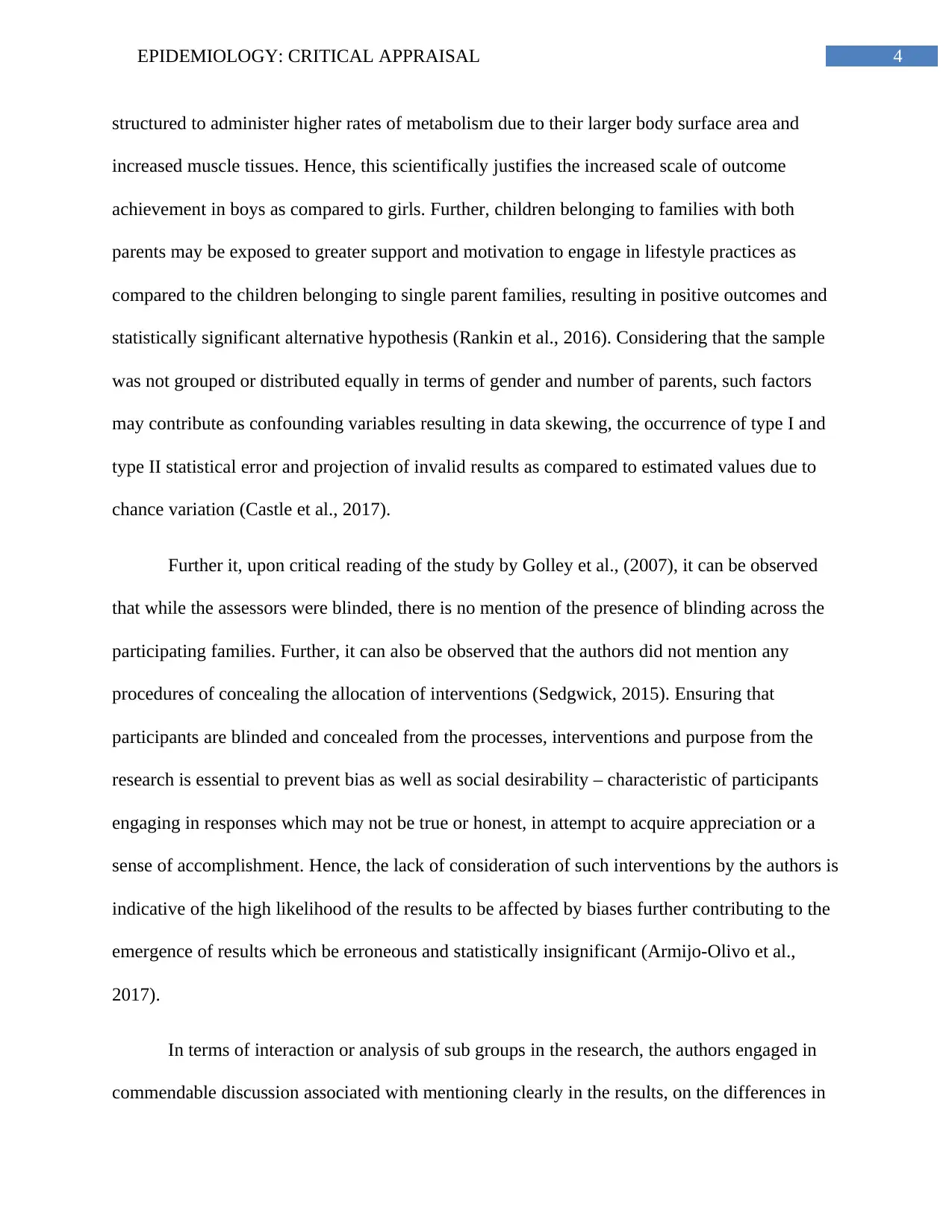
4EPIDEMIOLOGY: CRITICAL APPRAISAL
structured to administer higher rates of metabolism due to their larger body surface area and
increased muscle tissues. Hence, this scientifically justifies the increased scale of outcome
achievement in boys as compared to girls. Further, children belonging to families with both
parents may be exposed to greater support and motivation to engage in lifestyle practices as
compared to the children belonging to single parent families, resulting in positive outcomes and
statistically significant alternative hypothesis (Rankin et al., 2016). Considering that the sample
was not grouped or distributed equally in terms of gender and number of parents, such factors
may contribute as confounding variables resulting in data skewing, the occurrence of type I and
type II statistical error and projection of invalid results as compared to estimated values due to
chance variation (Castle et al., 2017).
Further it, upon critical reading of the study by Golley et al., (2007), it can be observed
that while the assessors were blinded, there is no mention of the presence of blinding across the
participating families. Further, it can also be observed that the authors did not mention any
procedures of concealing the allocation of interventions (Sedgwick, 2015). Ensuring that
participants are blinded and concealed from the processes, interventions and purpose from the
research is essential to prevent bias as well as social desirability – characteristic of participants
engaging in responses which may not be true or honest, in attempt to acquire appreciation or a
sense of accomplishment. Hence, the lack of consideration of such interventions by the authors is
indicative of the high likelihood of the results to be affected by biases further contributing to the
emergence of results which be erroneous and statistically insignificant (Armijo-Olivo et al.,
2017).
In terms of interaction or analysis of sub groups in the research, the authors engaged in
commendable discussion associated with mentioning clearly in the results, on the differences in
structured to administer higher rates of metabolism due to their larger body surface area and
increased muscle tissues. Hence, this scientifically justifies the increased scale of outcome
achievement in boys as compared to girls. Further, children belonging to families with both
parents may be exposed to greater support and motivation to engage in lifestyle practices as
compared to the children belonging to single parent families, resulting in positive outcomes and
statistically significant alternative hypothesis (Rankin et al., 2016). Considering that the sample
was not grouped or distributed equally in terms of gender and number of parents, such factors
may contribute as confounding variables resulting in data skewing, the occurrence of type I and
type II statistical error and projection of invalid results as compared to estimated values due to
chance variation (Castle et al., 2017).
Further it, upon critical reading of the study by Golley et al., (2007), it can be observed
that while the assessors were blinded, there is no mention of the presence of blinding across the
participating families. Further, it can also be observed that the authors did not mention any
procedures of concealing the allocation of interventions (Sedgwick, 2015). Ensuring that
participants are blinded and concealed from the processes, interventions and purpose from the
research is essential to prevent bias as well as social desirability – characteristic of participants
engaging in responses which may not be true or honest, in attempt to acquire appreciation or a
sense of accomplishment. Hence, the lack of consideration of such interventions by the authors is
indicative of the high likelihood of the results to be affected by biases further contributing to the
emergence of results which be erroneous and statistically insignificant (Armijo-Olivo et al.,
2017).
In terms of interaction or analysis of sub groups in the research, the authors engaged in
commendable discussion associated with mentioning clearly in the results, on the differences in
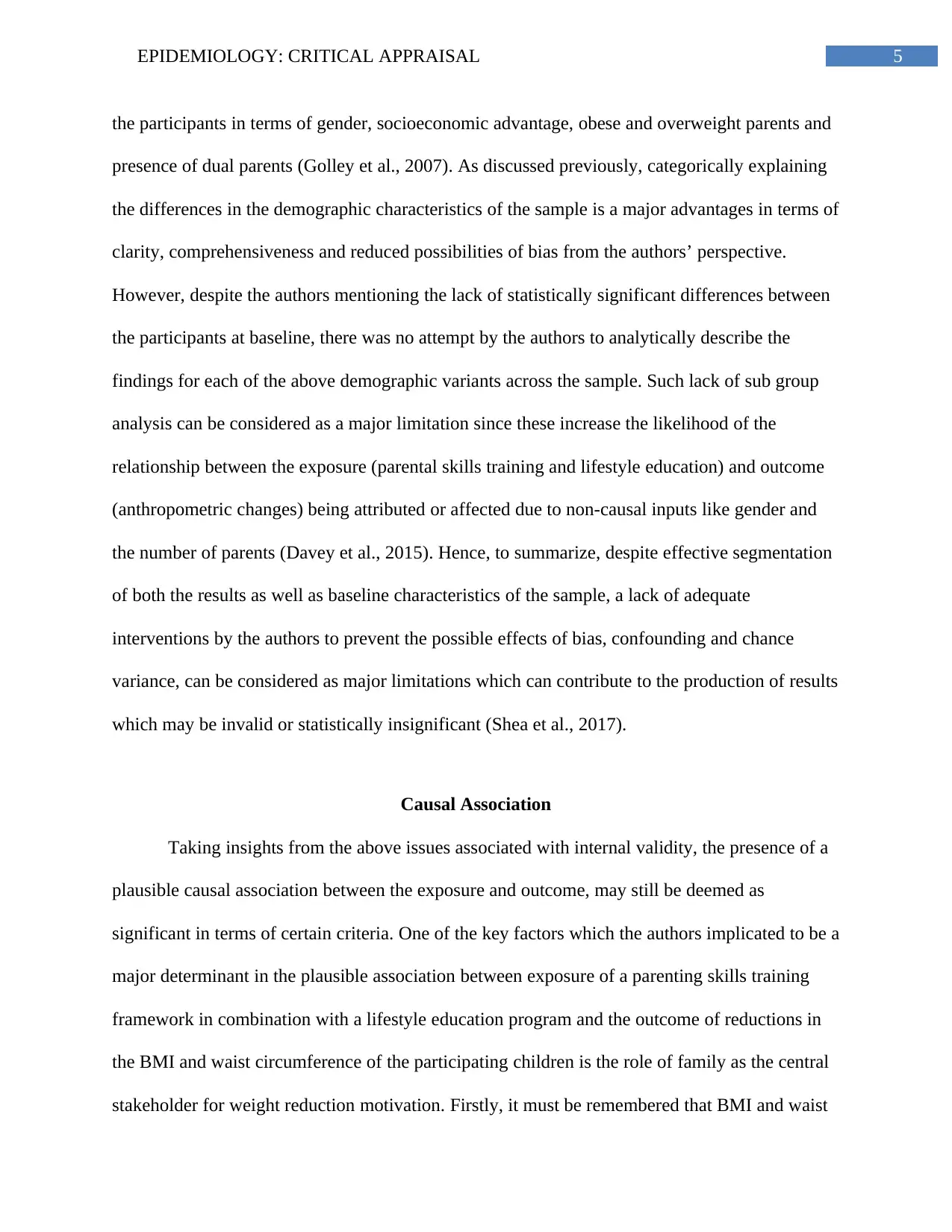
5EPIDEMIOLOGY: CRITICAL APPRAISAL
the participants in terms of gender, socioeconomic advantage, obese and overweight parents and
presence of dual parents (Golley et al., 2007). As discussed previously, categorically explaining
the differences in the demographic characteristics of the sample is a major advantages in terms of
clarity, comprehensiveness and reduced possibilities of bias from the authors’ perspective.
However, despite the authors mentioning the lack of statistically significant differences between
the participants at baseline, there was no attempt by the authors to analytically describe the
findings for each of the above demographic variants across the sample. Such lack of sub group
analysis can be considered as a major limitation since these increase the likelihood of the
relationship between the exposure (parental skills training and lifestyle education) and outcome
(anthropometric changes) being attributed or affected due to non-causal inputs like gender and
the number of parents (Davey et al., 2015). Hence, to summarize, despite effective segmentation
of both the results as well as baseline characteristics of the sample, a lack of adequate
interventions by the authors to prevent the possible effects of bias, confounding and chance
variance, can be considered as major limitations which can contribute to the production of results
which may be invalid or statistically insignificant (Shea et al., 2017).
Causal Association
Taking insights from the above issues associated with internal validity, the presence of a
plausible causal association between the exposure and outcome, may still be deemed as
significant in terms of certain criteria. One of the key factors which the authors implicated to be a
major determinant in the plausible association between exposure of a parenting skills training
framework in combination with a lifestyle education program and the outcome of reductions in
the BMI and waist circumference of the participating children is the role of family as the central
stakeholder for weight reduction motivation. Firstly, it must be remembered that BMI and waist
the participants in terms of gender, socioeconomic advantage, obese and overweight parents and
presence of dual parents (Golley et al., 2007). As discussed previously, categorically explaining
the differences in the demographic characteristics of the sample is a major advantages in terms of
clarity, comprehensiveness and reduced possibilities of bias from the authors’ perspective.
However, despite the authors mentioning the lack of statistically significant differences between
the participants at baseline, there was no attempt by the authors to analytically describe the
findings for each of the above demographic variants across the sample. Such lack of sub group
analysis can be considered as a major limitation since these increase the likelihood of the
relationship between the exposure (parental skills training and lifestyle education) and outcome
(anthropometric changes) being attributed or affected due to non-causal inputs like gender and
the number of parents (Davey et al., 2015). Hence, to summarize, despite effective segmentation
of both the results as well as baseline characteristics of the sample, a lack of adequate
interventions by the authors to prevent the possible effects of bias, confounding and chance
variance, can be considered as major limitations which can contribute to the production of results
which may be invalid or statistically insignificant (Shea et al., 2017).
Causal Association
Taking insights from the above issues associated with internal validity, the presence of a
plausible causal association between the exposure and outcome, may still be deemed as
significant in terms of certain criteria. One of the key factors which the authors implicated to be a
major determinant in the plausible association between exposure of a parenting skills training
framework in combination with a lifestyle education program and the outcome of reductions in
the BMI and waist circumference of the participating children is the role of family as the central
stakeholder for weight reduction motivation. Firstly, it must be remembered that BMI and waist
⊘ This is a preview!⊘
Do you want full access?
Subscribe today to unlock all pages.

Trusted by 1+ million students worldwide
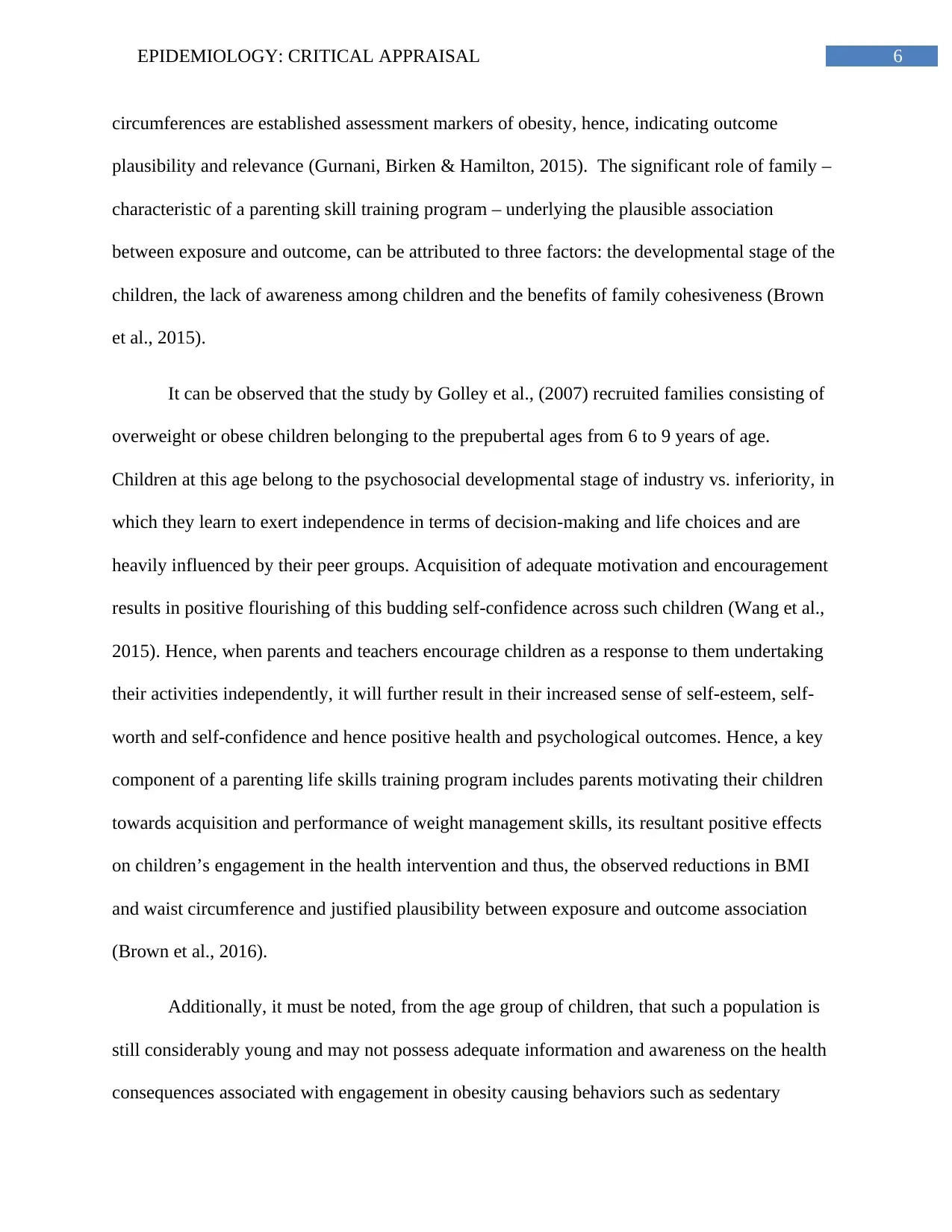
6EPIDEMIOLOGY: CRITICAL APPRAISAL
circumferences are established assessment markers of obesity, hence, indicating outcome
plausibility and relevance (Gurnani, Birken & Hamilton, 2015). The significant role of family –
characteristic of a parenting skill training program – underlying the plausible association
between exposure and outcome, can be attributed to three factors: the developmental stage of the
children, the lack of awareness among children and the benefits of family cohesiveness (Brown
et al., 2015).
It can be observed that the study by Golley et al., (2007) recruited families consisting of
overweight or obese children belonging to the prepubertal ages from 6 to 9 years of age.
Children at this age belong to the psychosocial developmental stage of industry vs. inferiority, in
which they learn to exert independence in terms of decision-making and life choices and are
heavily influenced by their peer groups. Acquisition of adequate motivation and encouragement
results in positive flourishing of this budding self-confidence across such children (Wang et al.,
2015). Hence, when parents and teachers encourage children as a response to them undertaking
their activities independently, it will further result in their increased sense of self-esteem, self-
worth and self-confidence and hence positive health and psychological outcomes. Hence, a key
component of a parenting life skills training program includes parents motivating their children
towards acquisition and performance of weight management skills, its resultant positive effects
on children’s engagement in the health intervention and thus, the observed reductions in BMI
and waist circumference and justified plausibility between exposure and outcome association
(Brown et al., 2016).
Additionally, it must be noted, from the age group of children, that such a population is
still considerably young and may not possess adequate information and awareness on the health
consequences associated with engagement in obesity causing behaviors such as sedentary
circumferences are established assessment markers of obesity, hence, indicating outcome
plausibility and relevance (Gurnani, Birken & Hamilton, 2015). The significant role of family –
characteristic of a parenting skill training program – underlying the plausible association
between exposure and outcome, can be attributed to three factors: the developmental stage of the
children, the lack of awareness among children and the benefits of family cohesiveness (Brown
et al., 2015).
It can be observed that the study by Golley et al., (2007) recruited families consisting of
overweight or obese children belonging to the prepubertal ages from 6 to 9 years of age.
Children at this age belong to the psychosocial developmental stage of industry vs. inferiority, in
which they learn to exert independence in terms of decision-making and life choices and are
heavily influenced by their peer groups. Acquisition of adequate motivation and encouragement
results in positive flourishing of this budding self-confidence across such children (Wang et al.,
2015). Hence, when parents and teachers encourage children as a response to them undertaking
their activities independently, it will further result in their increased sense of self-esteem, self-
worth and self-confidence and hence positive health and psychological outcomes. Hence, a key
component of a parenting life skills training program includes parents motivating their children
towards acquisition and performance of weight management skills, its resultant positive effects
on children’s engagement in the health intervention and thus, the observed reductions in BMI
and waist circumference and justified plausibility between exposure and outcome association
(Brown et al., 2016).
Additionally, it must be noted, from the age group of children, that such a population is
still considerably young and may not possess adequate information and awareness on the health
consequences associated with engagement in obesity causing behaviors such as sedentary
Paraphrase This Document
Need a fresh take? Get an instant paraphrase of this document with our AI Paraphraser
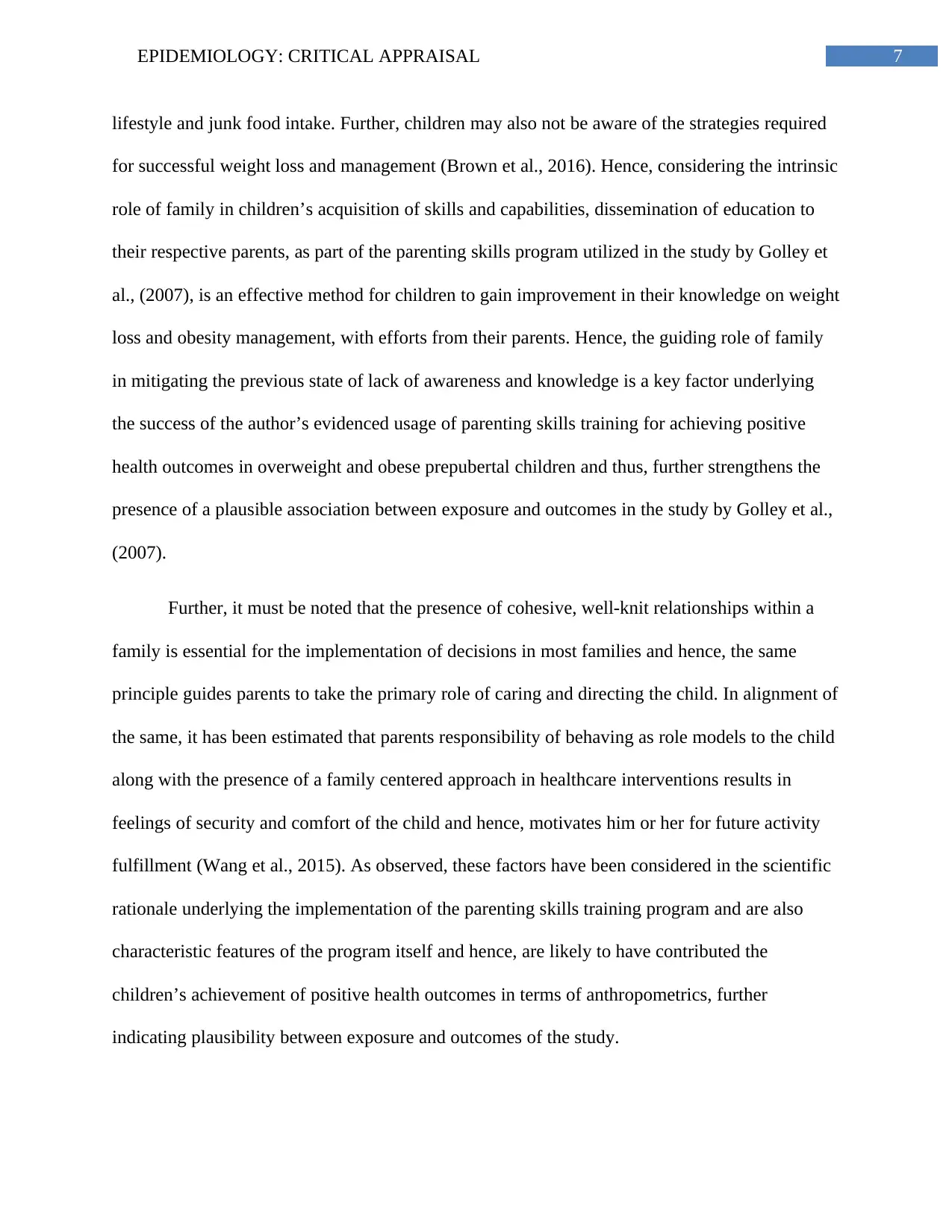
7EPIDEMIOLOGY: CRITICAL APPRAISAL
lifestyle and junk food intake. Further, children may also not be aware of the strategies required
for successful weight loss and management (Brown et al., 2016). Hence, considering the intrinsic
role of family in children’s acquisition of skills and capabilities, dissemination of education to
their respective parents, as part of the parenting skills program utilized in the study by Golley et
al., (2007), is an effective method for children to gain improvement in their knowledge on weight
loss and obesity management, with efforts from their parents. Hence, the guiding role of family
in mitigating the previous state of lack of awareness and knowledge is a key factor underlying
the success of the author’s evidenced usage of parenting skills training for achieving positive
health outcomes in overweight and obese prepubertal children and thus, further strengthens the
presence of a plausible association between exposure and outcomes in the study by Golley et al.,
(2007).
Further, it must be noted that the presence of cohesive, well-knit relationships within a
family is essential for the implementation of decisions in most families and hence, the same
principle guides parents to take the primary role of caring and directing the child. In alignment of
the same, it has been estimated that parents responsibility of behaving as role models to the child
along with the presence of a family centered approach in healthcare interventions results in
feelings of security and comfort of the child and hence, motivates him or her for future activity
fulfillment (Wang et al., 2015). As observed, these factors have been considered in the scientific
rationale underlying the implementation of the parenting skills training program and are also
characteristic features of the program itself and hence, are likely to have contributed the
children’s achievement of positive health outcomes in terms of anthropometrics, further
indicating plausibility between exposure and outcomes of the study.
lifestyle and junk food intake. Further, children may also not be aware of the strategies required
for successful weight loss and management (Brown et al., 2016). Hence, considering the intrinsic
role of family in children’s acquisition of skills and capabilities, dissemination of education to
their respective parents, as part of the parenting skills program utilized in the study by Golley et
al., (2007), is an effective method for children to gain improvement in their knowledge on weight
loss and obesity management, with efforts from their parents. Hence, the guiding role of family
in mitigating the previous state of lack of awareness and knowledge is a key factor underlying
the success of the author’s evidenced usage of parenting skills training for achieving positive
health outcomes in overweight and obese prepubertal children and thus, further strengthens the
presence of a plausible association between exposure and outcomes in the study by Golley et al.,
(2007).
Further, it must be noted that the presence of cohesive, well-knit relationships within a
family is essential for the implementation of decisions in most families and hence, the same
principle guides parents to take the primary role of caring and directing the child. In alignment of
the same, it has been estimated that parents responsibility of behaving as role models to the child
along with the presence of a family centered approach in healthcare interventions results in
feelings of security and comfort of the child and hence, motivates him or her for future activity
fulfillment (Wang et al., 2015). As observed, these factors have been considered in the scientific
rationale underlying the implementation of the parenting skills training program and are also
characteristic features of the program itself and hence, are likely to have contributed the
children’s achievement of positive health outcomes in terms of anthropometrics, further
indicating plausibility between exposure and outcomes of the study.
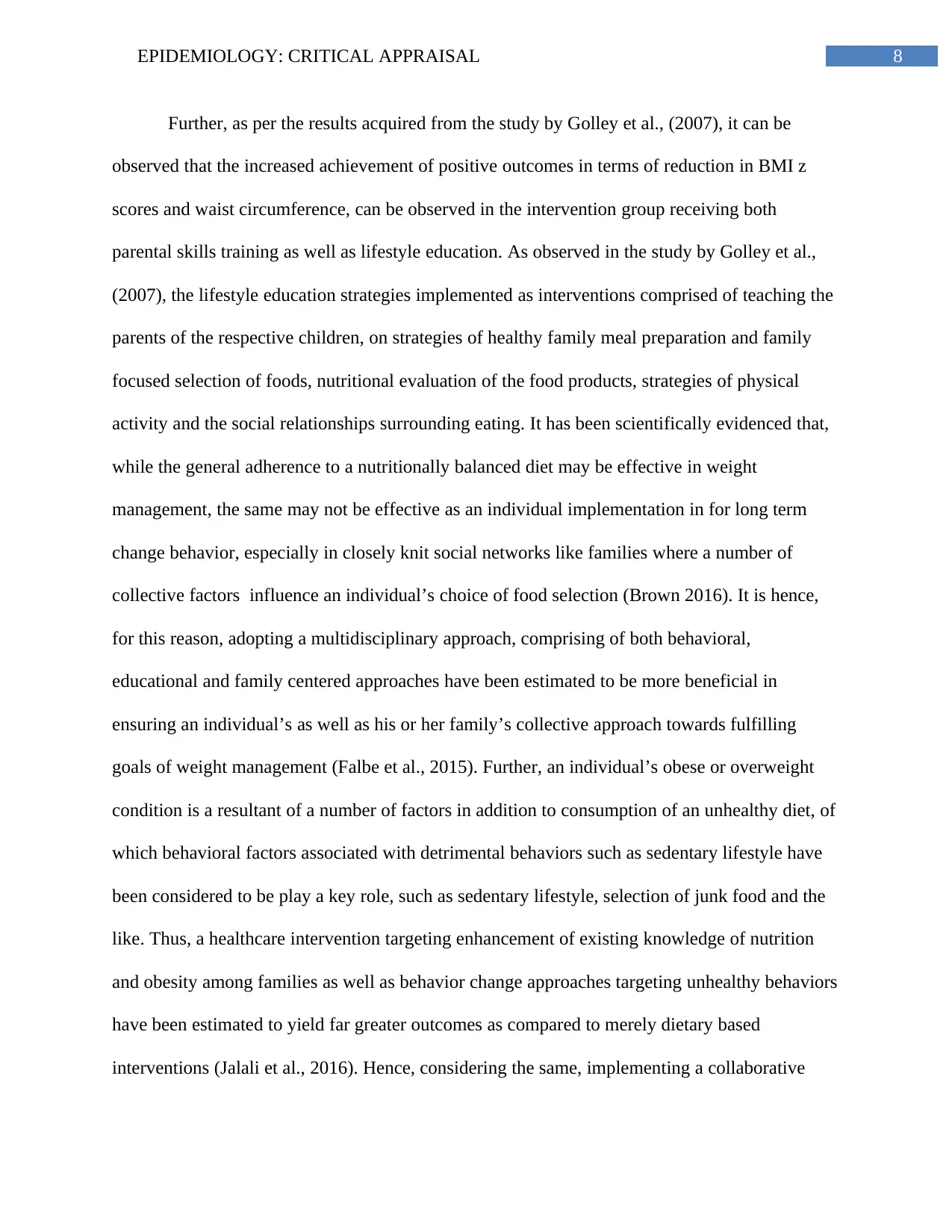
8EPIDEMIOLOGY: CRITICAL APPRAISAL
Further, as per the results acquired from the study by Golley et al., (2007), it can be
observed that the increased achievement of positive outcomes in terms of reduction in BMI z
scores and waist circumference, can be observed in the intervention group receiving both
parental skills training as well as lifestyle education. As observed in the study by Golley et al.,
(2007), the lifestyle education strategies implemented as interventions comprised of teaching the
parents of the respective children, on strategies of healthy family meal preparation and family
focused selection of foods, nutritional evaluation of the food products, strategies of physical
activity and the social relationships surrounding eating. It has been scientifically evidenced that,
while the general adherence to a nutritionally balanced diet may be effective in weight
management, the same may not be effective as an individual implementation in for long term
change behavior, especially in closely knit social networks like families where a number of
collective factors influence an individual’s choice of food selection (Brown 2016). It is hence,
for this reason, adopting a multidisciplinary approach, comprising of both behavioral,
educational and family centered approaches have been estimated to be more beneficial in
ensuring an individual’s as well as his or her family’s collective approach towards fulfilling
goals of weight management (Falbe et al., 2015). Further, an individual’s obese or overweight
condition is a resultant of a number of factors in addition to consumption of an unhealthy diet, of
which behavioral factors associated with detrimental behaviors such as sedentary lifestyle have
been considered to be play a key role, such as sedentary lifestyle, selection of junk food and the
like. Thus, a healthcare intervention targeting enhancement of existing knowledge of nutrition
and obesity among families as well as behavior change approaches targeting unhealthy behaviors
have been estimated to yield far greater outcomes as compared to merely dietary based
interventions (Jalali et al., 2016). Hence, considering the same, implementing a collaborative
Further, as per the results acquired from the study by Golley et al., (2007), it can be
observed that the increased achievement of positive outcomes in terms of reduction in BMI z
scores and waist circumference, can be observed in the intervention group receiving both
parental skills training as well as lifestyle education. As observed in the study by Golley et al.,
(2007), the lifestyle education strategies implemented as interventions comprised of teaching the
parents of the respective children, on strategies of healthy family meal preparation and family
focused selection of foods, nutritional evaluation of the food products, strategies of physical
activity and the social relationships surrounding eating. It has been scientifically evidenced that,
while the general adherence to a nutritionally balanced diet may be effective in weight
management, the same may not be effective as an individual implementation in for long term
change behavior, especially in closely knit social networks like families where a number of
collective factors influence an individual’s choice of food selection (Brown 2016). It is hence,
for this reason, adopting a multidisciplinary approach, comprising of both behavioral,
educational and family centered approaches have been estimated to be more beneficial in
ensuring an individual’s as well as his or her family’s collective approach towards fulfilling
goals of weight management (Falbe et al., 2015). Further, an individual’s obese or overweight
condition is a resultant of a number of factors in addition to consumption of an unhealthy diet, of
which behavioral factors associated with detrimental behaviors such as sedentary lifestyle have
been considered to be play a key role, such as sedentary lifestyle, selection of junk food and the
like. Thus, a healthcare intervention targeting enhancement of existing knowledge of nutrition
and obesity among families as well as behavior change approaches targeting unhealthy behaviors
have been estimated to yield far greater outcomes as compared to merely dietary based
interventions (Jalali et al., 2016). Hence, considering the same, implementing a collaborative
⊘ This is a preview!⊘
Do you want full access?
Subscribe today to unlock all pages.

Trusted by 1+ million students worldwide
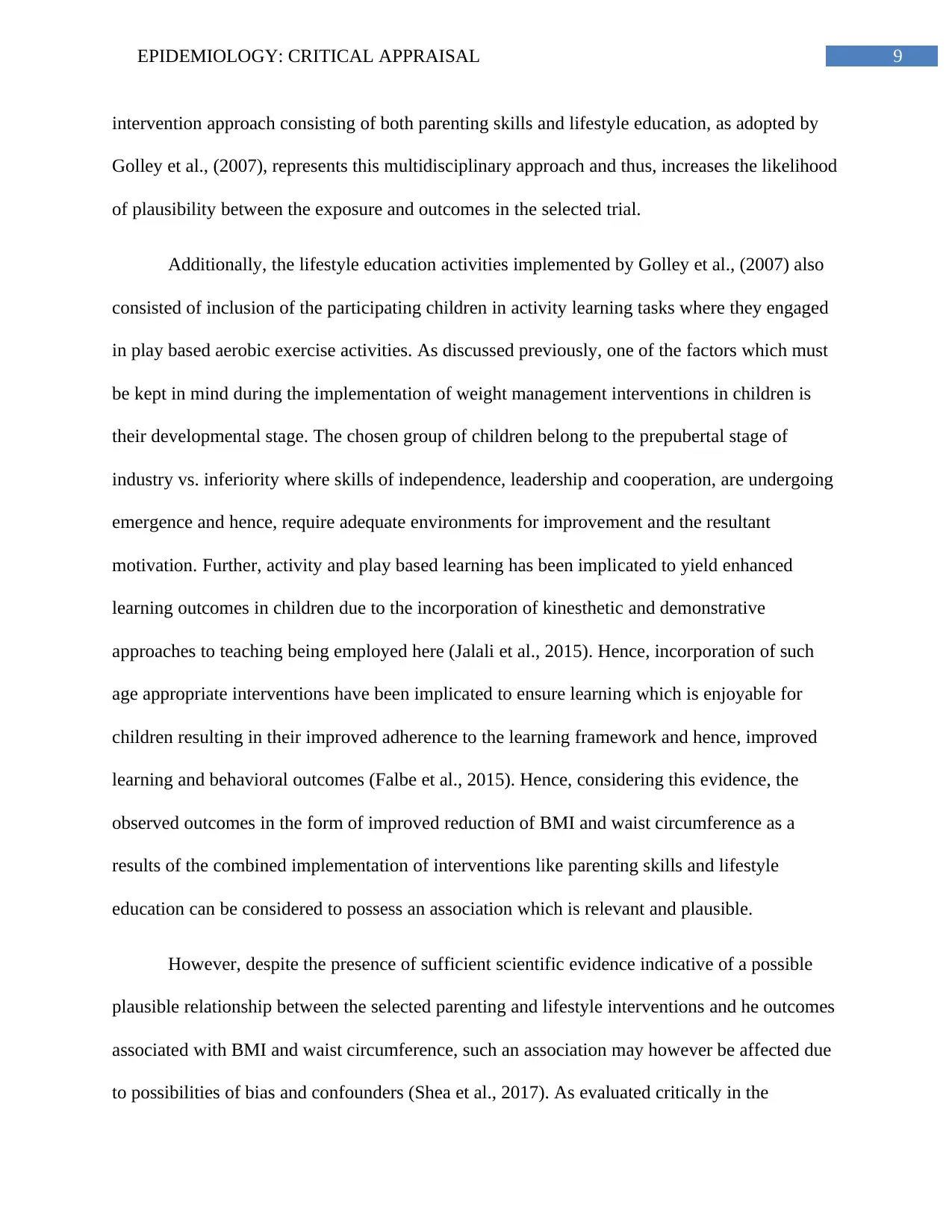
9EPIDEMIOLOGY: CRITICAL APPRAISAL
intervention approach consisting of both parenting skills and lifestyle education, as adopted by
Golley et al., (2007), represents this multidisciplinary approach and thus, increases the likelihood
of plausibility between the exposure and outcomes in the selected trial.
Additionally, the lifestyle education activities implemented by Golley et al., (2007) also
consisted of inclusion of the participating children in activity learning tasks where they engaged
in play based aerobic exercise activities. As discussed previously, one of the factors which must
be kept in mind during the implementation of weight management interventions in children is
their developmental stage. The chosen group of children belong to the prepubertal stage of
industry vs. inferiority where skills of independence, leadership and cooperation, are undergoing
emergence and hence, require adequate environments for improvement and the resultant
motivation. Further, activity and play based learning has been implicated to yield enhanced
learning outcomes in children due to the incorporation of kinesthetic and demonstrative
approaches to teaching being employed here (Jalali et al., 2015). Hence, incorporation of such
age appropriate interventions have been implicated to ensure learning which is enjoyable for
children resulting in their improved adherence to the learning framework and hence, improved
learning and behavioral outcomes (Falbe et al., 2015). Hence, considering this evidence, the
observed outcomes in the form of improved reduction of BMI and waist circumference as a
results of the combined implementation of interventions like parenting skills and lifestyle
education can be considered to possess an association which is relevant and plausible.
However, despite the presence of sufficient scientific evidence indicative of a possible
plausible relationship between the selected parenting and lifestyle interventions and he outcomes
associated with BMI and waist circumference, such an association may however be affected due
to possibilities of bias and confounders (Shea et al., 2017). As evaluated critically in the
intervention approach consisting of both parenting skills and lifestyle education, as adopted by
Golley et al., (2007), represents this multidisciplinary approach and thus, increases the likelihood
of plausibility between the exposure and outcomes in the selected trial.
Additionally, the lifestyle education activities implemented by Golley et al., (2007) also
consisted of inclusion of the participating children in activity learning tasks where they engaged
in play based aerobic exercise activities. As discussed previously, one of the factors which must
be kept in mind during the implementation of weight management interventions in children is
their developmental stage. The chosen group of children belong to the prepubertal stage of
industry vs. inferiority where skills of independence, leadership and cooperation, are undergoing
emergence and hence, require adequate environments for improvement and the resultant
motivation. Further, activity and play based learning has been implicated to yield enhanced
learning outcomes in children due to the incorporation of kinesthetic and demonstrative
approaches to teaching being employed here (Jalali et al., 2015). Hence, incorporation of such
age appropriate interventions have been implicated to ensure learning which is enjoyable for
children resulting in their improved adherence to the learning framework and hence, improved
learning and behavioral outcomes (Falbe et al., 2015). Hence, considering this evidence, the
observed outcomes in the form of improved reduction of BMI and waist circumference as a
results of the combined implementation of interventions like parenting skills and lifestyle
education can be considered to possess an association which is relevant and plausible.
However, despite the presence of sufficient scientific evidence indicative of a possible
plausible relationship between the selected parenting and lifestyle interventions and he outcomes
associated with BMI and waist circumference, such an association may however be affected due
to possibilities of bias and confounders (Shea et al., 2017). As evaluated critically in the
Paraphrase This Document
Need a fresh take? Get an instant paraphrase of this document with our AI Paraphraser
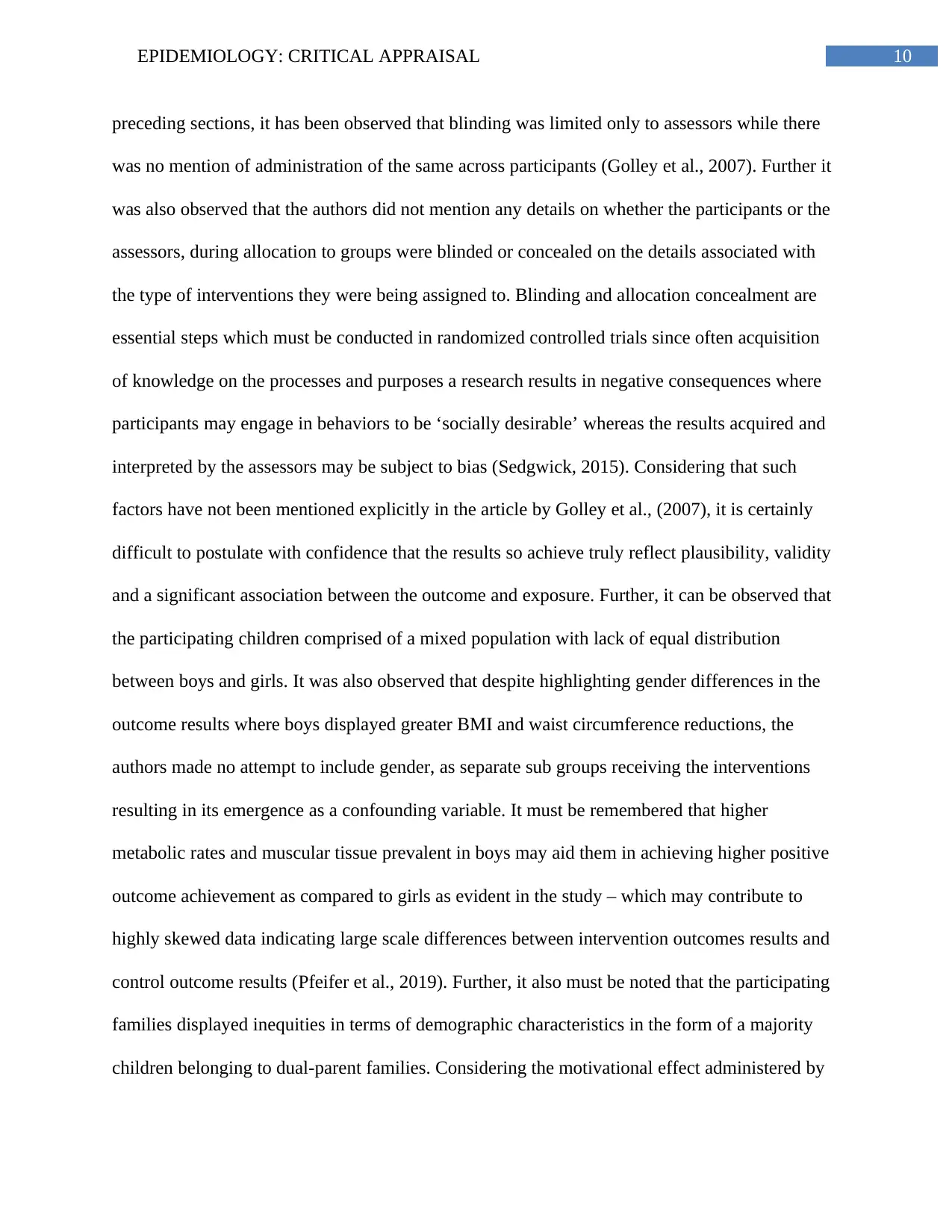
10EPIDEMIOLOGY: CRITICAL APPRAISAL
preceding sections, it has been observed that blinding was limited only to assessors while there
was no mention of administration of the same across participants (Golley et al., 2007). Further it
was also observed that the authors did not mention any details on whether the participants or the
assessors, during allocation to groups were blinded or concealed on the details associated with
the type of interventions they were being assigned to. Blinding and allocation concealment are
essential steps which must be conducted in randomized controlled trials since often acquisition
of knowledge on the processes and purposes a research results in negative consequences where
participants may engage in behaviors to be ‘socially desirable’ whereas the results acquired and
interpreted by the assessors may be subject to bias (Sedgwick, 2015). Considering that such
factors have not been mentioned explicitly in the article by Golley et al., (2007), it is certainly
difficult to postulate with confidence that the results so achieve truly reflect plausibility, validity
and a significant association between the outcome and exposure. Further, it can be observed that
the participating children comprised of a mixed population with lack of equal distribution
between boys and girls. It was also observed that despite highlighting gender differences in the
outcome results where boys displayed greater BMI and waist circumference reductions, the
authors made no attempt to include gender, as separate sub groups receiving the interventions
resulting in its emergence as a confounding variable. It must be remembered that higher
metabolic rates and muscular tissue prevalent in boys may aid them in achieving higher positive
outcome achievement as compared to girls as evident in the study – which may contribute to
highly skewed data indicating large scale differences between intervention outcomes results and
control outcome results (Pfeifer et al., 2019). Further, it also must be noted that the participating
families displayed inequities in terms of demographic characteristics in the form of a majority
children belonging to dual-parent families. Considering the motivational effect administered by
preceding sections, it has been observed that blinding was limited only to assessors while there
was no mention of administration of the same across participants (Golley et al., 2007). Further it
was also observed that the authors did not mention any details on whether the participants or the
assessors, during allocation to groups were blinded or concealed on the details associated with
the type of interventions they were being assigned to. Blinding and allocation concealment are
essential steps which must be conducted in randomized controlled trials since often acquisition
of knowledge on the processes and purposes a research results in negative consequences where
participants may engage in behaviors to be ‘socially desirable’ whereas the results acquired and
interpreted by the assessors may be subject to bias (Sedgwick, 2015). Considering that such
factors have not been mentioned explicitly in the article by Golley et al., (2007), it is certainly
difficult to postulate with confidence that the results so achieve truly reflect plausibility, validity
and a significant association between the outcome and exposure. Further, it can be observed that
the participating children comprised of a mixed population with lack of equal distribution
between boys and girls. It was also observed that despite highlighting gender differences in the
outcome results where boys displayed greater BMI and waist circumference reductions, the
authors made no attempt to include gender, as separate sub groups receiving the interventions
resulting in its emergence as a confounding variable. It must be remembered that higher
metabolic rates and muscular tissue prevalent in boys may aid them in achieving higher positive
outcome achievement as compared to girls as evident in the study – which may contribute to
highly skewed data indicating large scale differences between intervention outcomes results and
control outcome results (Pfeifer et al., 2019). Further, it also must be noted that the participating
families displayed inequities in terms of demographic characteristics in the form of a majority
children belonging to dual-parent families. Considering the motivational effect administered by
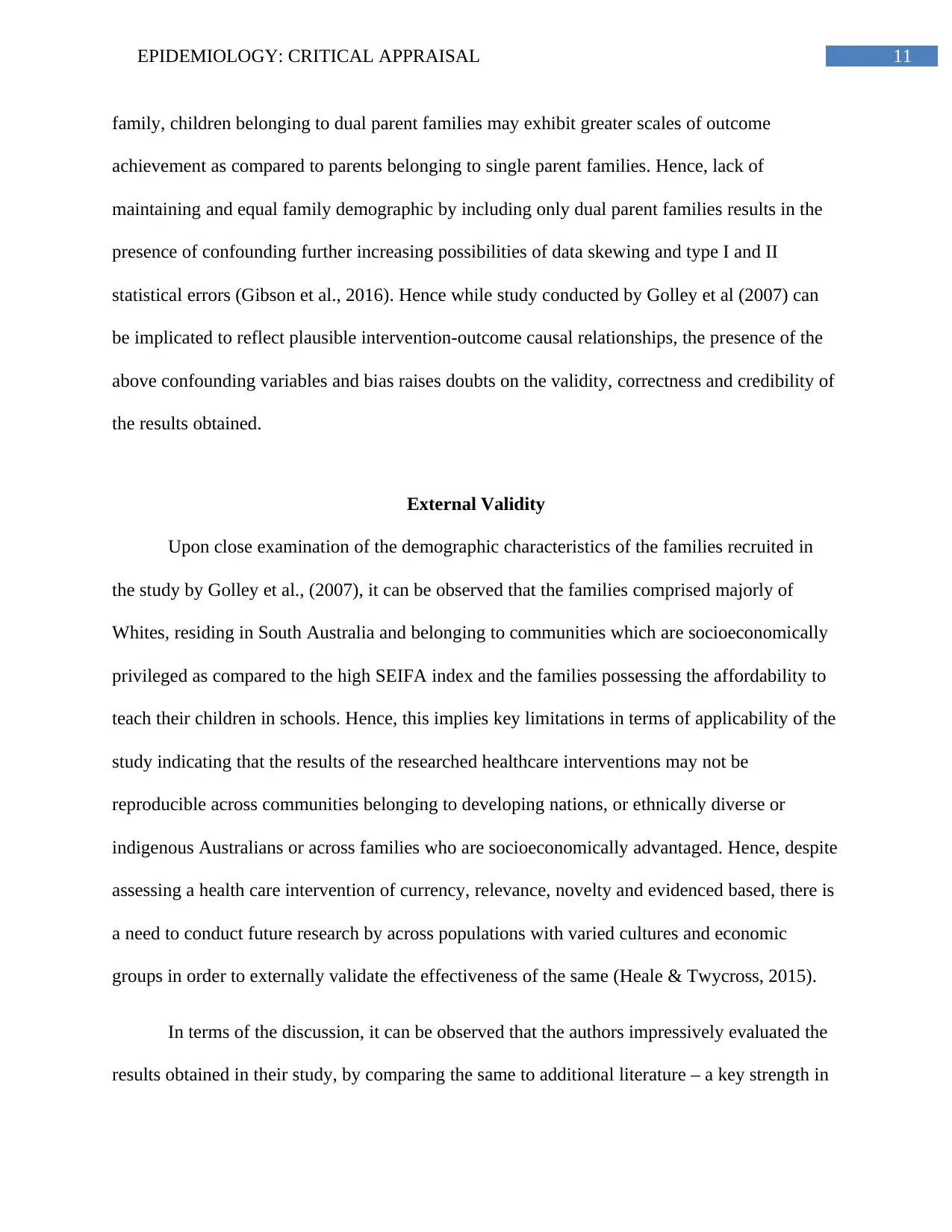
11EPIDEMIOLOGY: CRITICAL APPRAISAL
family, children belonging to dual parent families may exhibit greater scales of outcome
achievement as compared to parents belonging to single parent families. Hence, lack of
maintaining and equal family demographic by including only dual parent families results in the
presence of confounding further increasing possibilities of data skewing and type I and II
statistical errors (Gibson et al., 2016). Hence while study conducted by Golley et al (2007) can
be implicated to reflect plausible intervention-outcome causal relationships, the presence of the
above confounding variables and bias raises doubts on the validity, correctness and credibility of
the results obtained.
External Validity
Upon close examination of the demographic characteristics of the families recruited in
the study by Golley et al., (2007), it can be observed that the families comprised majorly of
Whites, residing in South Australia and belonging to communities which are socioeconomically
privileged as compared to the high SEIFA index and the families possessing the affordability to
teach their children in schools. Hence, this implies key limitations in terms of applicability of the
study indicating that the results of the researched healthcare interventions may not be
reproducible across communities belonging to developing nations, or ethnically diverse or
indigenous Australians or across families who are socioeconomically advantaged. Hence, despite
assessing a health care intervention of currency, relevance, novelty and evidenced based, there is
a need to conduct future research by across populations with varied cultures and economic
groups in order to externally validate the effectiveness of the same (Heale & Twycross, 2015).
In terms of the discussion, it can be observed that the authors impressively evaluated the
results obtained in their study, by comparing the same to additional literature – a key strength in
family, children belonging to dual parent families may exhibit greater scales of outcome
achievement as compared to parents belonging to single parent families. Hence, lack of
maintaining and equal family demographic by including only dual parent families results in the
presence of confounding further increasing possibilities of data skewing and type I and II
statistical errors (Gibson et al., 2016). Hence while study conducted by Golley et al (2007) can
be implicated to reflect plausible intervention-outcome causal relationships, the presence of the
above confounding variables and bias raises doubts on the validity, correctness and credibility of
the results obtained.
External Validity
Upon close examination of the demographic characteristics of the families recruited in
the study by Golley et al., (2007), it can be observed that the families comprised majorly of
Whites, residing in South Australia and belonging to communities which are socioeconomically
privileged as compared to the high SEIFA index and the families possessing the affordability to
teach their children in schools. Hence, this implies key limitations in terms of applicability of the
study indicating that the results of the researched healthcare interventions may not be
reproducible across communities belonging to developing nations, or ethnically diverse or
indigenous Australians or across families who are socioeconomically advantaged. Hence, despite
assessing a health care intervention of currency, relevance, novelty and evidenced based, there is
a need to conduct future research by across populations with varied cultures and economic
groups in order to externally validate the effectiveness of the same (Heale & Twycross, 2015).
In terms of the discussion, it can be observed that the authors impressively evaluated the
results obtained in their study, by comparing the same to additional literature – a key strength in
⊘ This is a preview!⊘
Do you want full access?
Subscribe today to unlock all pages.

Trusted by 1+ million students worldwide
1 out of 17
Related Documents
Your All-in-One AI-Powered Toolkit for Academic Success.
+13062052269
info@desklib.com
Available 24*7 on WhatsApp / Email
![[object Object]](/_next/static/media/star-bottom.7253800d.svg)
Unlock your academic potential
Copyright © 2020–2025 A2Z Services. All Rights Reserved. Developed and managed by ZUCOL.





